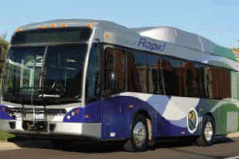Sustainability’s Many Faces: Beacon Award Program Participants Create Vibrant Communities
Yvonne Hunter is co-director of the Institute for Local Government’s Sustainability Program. Jessica Aviña Tong is a former program coordinator for the Institute for Local Government.
Sustainability is all about making communities more livable — creating healthy, dynamic places to live and work while simultaneously saving money, energy and resources and helping the local economy. Cities and counties throughout California are demonstrating leadership in creating active, lively communities by adopting policies and programs that support sustainability. This diverse range of activities brightens the future of their communities.
Forty-one cities and counties are participating in the sustainability and climate change recognition program known as the Beacon Award: Local Leadership Toward Solving Climate Change. These participants reflect the diversity of local agencies working to save resources, reduce greenhouse gas emissions and create healthy communities. The Beacon Award (www.ca-ilg.org/BeaconAward) is a program of the Institute for Local Government and the Statewide Energy Efficiency Collaborative (www.CaliforniaSEEC.org).
The accomplishments of Beacon Award participants shine a bright light on the ability of California local agencies to voluntarily address sustainability issues. The range of policies and programs explored here provides a sampling of their efforts. (To learn about the energy-efficiency accomplishments of Beacon Award communities, see “Spotlighting Energy Efficiency in California Communities”).
Water Conservation
To reduce the amount of water used for landscaped areas, Simi Valley, Woodland and Santa Clarita installed weather-based, water-efficient irrigation systems for city parks and open spaces. The systems not only reduce the amount of irrigated water used by about 25 percent, but they also save energy and staff resources.
Manhattan Beach and Glendale encourage residents to conserve water by providing free classes on water-smart irrigation and water-efficient plants. Manhattan Beach also offers residents free landscape audits that help identify opportunities to convert traditional gardens to California-friendly, drought-tolerant landscaping.
Sacramento’s Water Wise Garden at the city’s Water Conservation Office includes native and drought-tolerant plants, low-volume irrigation, mulch and other water-saving features. Educational signage provides tips on ways residents can implement water-efficient practices while still maintaining a beautiful landscape. The Water Wise Garden is 44 percent more water efficient than the previous landscaping at the site and is open to the public year-round for viewing.
Waste Reduction and Recycling
Many agencies use partnerships to reduce and recycle waste. The City of Santa Barbara worked with the Santa Barbara Unified School District to implement a food scrap recovery program at elementary schools and is expanding the project to secondary schools in the 2012–13 school year. Palm Springs started a compost pilot program for hotels and casinos, the largest producers of food waste in the city.
Sonoma County implemented a pilot composting program in its detention facilities, diverting approximately 1,200 pounds of food waste per month. The program is the first vermiculture composting (worm farm) program in a detention facility in the state. Inmates learn about green industry and acquire job skills, thus potentially reducing recidivism.
Pleasanton offers residents free electronic waste and pharmaceutical drop-off events twice a year. Each event collects about 700 pounds of pharmaceutical waste and 49,000 pounds of e-waste. South Gate partnered with its waste hauler to offer a free home delivery program for all residents in need of sharps disposal containers.
Green Purchasing
Besides adopting policies to buy recycled paper, green purchasing policies can be expanded to support local businesses. For example, Tulare’s Environmentally Preferable Purchasing Policy gives a 5 percent purchasing preference to bids from local vendors. By doing so, Tulare increases investment in the local economy and helps reduce greenhouse gas emissions associated with shipping or travel from outside the city.
Several cities use recycled materials in community upgrades. La Mesa uses recycled tires or wood chips for playground upgrades and replacement. Chula Vista completed a pilot project that incorporated recycled asphalt roof shingles into roadway pavement projects.
Sonoma County’s purchasing surplus program has reused 952 surplus office supplies and pieces of furniture since 2010, saving about $103,000. The county has also donated more than 1,200 surplus items to local nonprofit organizations.
Renewable Energy
San Rafael and Chula Vista require new construction to be solar ready by being pre-plumbed for solar hot water or pre-wired for solar photovoltaic systems.
Yolo County adopted an ordinance that sets criteria for siting and approving solar photovoltaic systems on agricultural and other open space lands in the county.
Efficient Transportation
Pleasanton teamed up with the Livermore-Amador Valley Transportation Authority to launch a new electric-hybrid bus service that connects riders to busy employment and shopping centers and mass transit stations. The limited-stop service uses innovative technology, such as bus signal priority, that reduces the number of stops at signals. This reduces idling and makes the trips faster.
Apple Valley adopted a multi-use trail plan and a bicycle system that include more than 31 miles of trails. New developments incorporate adjacent bike paths that pedestrians can also use.
Community Design
Simi Valley’s Affordable Housing Standards include incentives for projects that demonstrate strategies to reduce greenhouse gas emissions. Simi Valley also maintains a citywide database of vacant and underutilized infill sites to monitor the city’s growth and change, including annual reporting on the number of infill sites that were developed during the previous year.
Palo Alto allows mixed use on commercially zoned parcels and small retail services in residential projects, thus making walking and biking to and from retail services more feasible for residents.
Using Open Space
Conserving and maintaining open space provides multiple community benefits. Parks and open spaces offer community members places to walk, sit or play, as well as aesthetic beauty.
Over the past decade, Riverside planted more than 110,000 trees through its Tree Power Program, increasing its urban forest and community shade cover. These additional trees resulted in saving more than 16.2 million kilowatt hours of electricity, reducing greenhouse gas emissions by 24.6 million pounds, or 12.3 tons, and directing $500,000 in economic investment to local nurseries.
Using community open space for gardens can provide additional health benefits. Palm Springs and Palo Alto promote healthy eating by allowing residents to grow and harvest their own vegetables and herbs in city-provided community gardens. Glendale offers its residents four community gardens and three farmers markets, which help provide locally grown food.
Conclusion
The achievements highlighted here reflect the diversity of California communities, as well as local officials’ leadership in creating policies and programs tailored to local needs. Their creativity serves as an inspiration.
To learn more about these and other accomplishments of Beacon Award program participants, visit www.ca-ilg.org/BeaconAward/ParticipantAccomplishments.
Public Transit’s Additional Benefits
Besides providing more transportation options to residents and commuters, access to public transit helps seniors maintain their independence even after losing the ability to drive, thus decreasing the isolation that they may otherwise experience.
Engaging the Public in Sustainability
Santa Clarita’s website (GreenSantaClarita.com) provides information to the entire community about sustainability issues and resources. The website helps stimulate the green economy in Santa Clarita by making it easy and cost effective for residents, businesses and builders to “go green.”
South Gate hosts a variety of events for residents, such as Family Day in the Park, Street Fair and Earth Day. These occasions offer opportunities to share information about energy and water conservation.
This article appears in the July 2012 issue of Western City
Did you like what you read here? Subscribe
to Western City



